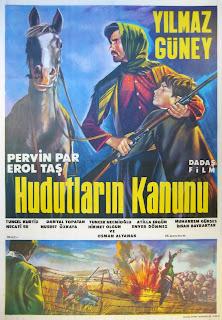
Credited with kicking off the “New Turkish Cinema”, where theatrics took a back seat to realism, director Lütfi Akad’s Law of the Border was shot on-location along the Turkish / Syrian frontier, and threw a spotlight on many of the social issues prevalent at the time in this particular region.
Hidir (Yilmaz Güney) makes a living smuggling livestock (mostly sheep) across the border. He is well-respected by the people in his village, yet the most important thing to Hidir is that he build a better future for his son. Though it angers his fellow smugglers, Hidir befriends the local military commander Lt. Zeki (Atilla Ergün) and lobbies for his tiny village to be the first in the area to construct a schoolhouse, where teacher Ayse (Pervin Par) will use her skills to show local kids there’s more to life than breaking the law.
But just as Hidir’s plans for his community are taking shape, he becomes embroiled in a tense situation by agreeing to help farmer Hasan (Osman Alyanek) move his sheep across the border, igniting a feud between himself and fellow smuggler Ali Cello (Erol Tas) that is destined to end in violence.
With its documentary-like approach and social commentary, Law of the Border had more in common with Italian Neorealism (Rome Open City, Bicycle Thieves) and the French New Wave (The 400 Blows) than it did the cinema of its own country. Up to that point, most Turkish movies were shot in a studio; by setting his story (which he co-wrote with star – and future director - Yilmaz Güney) out in the open, audiences could see first-hand the crippling poverty that rocked these areas.
Bringing social issues such as hunger and crime to the forefront, Akad established himself as one of that country’s most prominent filmmakers, and helped usher in what became known as Turkey’s “director’s era”. Though well-acted by Yilmaz Güney and Erol Tas (who two years earlier played the lead in Dry Summer), it’s Law of the Border’s realistic approach that will resonate with viewers, and the plight of its characters that will stay with them.
The truth is, we are lucky to have Law of the Border at all. Following a 1980 coup d’etat by the Turkish military, all prints of this film and many others, which were deemed “unflattering” to the new ideals, were gathered up and destroyed. Only a single, badly-damaged print of this movie remained, which Martin Scorsese and his World Cinema Project worked tirelessly to restore. Though rough around the edges (missing frames and audio issues abound throughout, and a grainy Betamax copy was used to fill in a missing reel), the film’s groundbreaking cinematic style as well as its central messages ring loud and clear. Kudos to Scorsese and his team, without whom this movie would have been only a rumor. Make it a point to see Law of the Border, because it’s a miracle that you still can.
Rating: 9 out of 10
